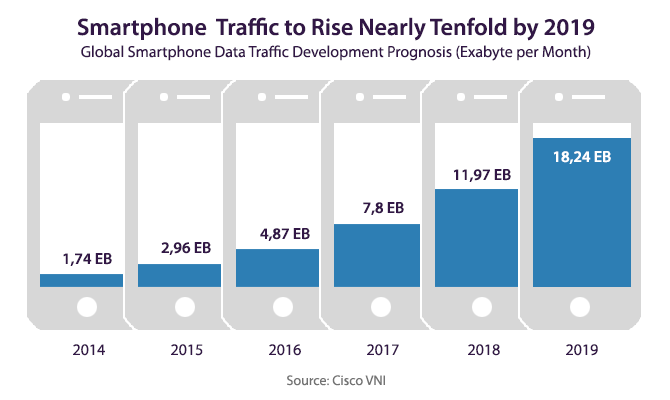
Mobile first? Audience first? – Everything is nothing without good content
To successfully place their messages becomes increasingly difficult for enterprises because of growing overstimulation by “anywhere content” and the associated content shock. Users are searching for content, which is involving and relates to them personally. But the resulting quality pressure is not the only challenge companies have to face.
It has been often predicted and announced for years that mobile is the next big thing. Now mobile is well on the way to become the dominating channel. According to a study by GfK consumer research association, younger internet users, aged between 14 and 29, spend 67% of their online time on the smartphone. Even older users, aged 55 or over, spend more time on the smartphone than on desktop computers. Across all age groups, 87% of the mobile usage time is spent with apps. And even if the use of smartphones differs by age group, the high use of mobile in comparison to the entire online usage, illustrates that the importance of internet usage with smartphones has risen across all age groups. The Cisco Visual Networking Index predicts a tenfold increase in global smartphone traffic until 2019. More smartphones, faster networks, and more convenient use of even big data content favor this development forecast.
Mobile takes it all
But that’s not all: companies that have not optimized their websites for mobile devices should think about that immediately. In mid-March of this year, Google announced a change to the algorithm which prefers mobile optimized results from May on. Last year the group had announced that more Google searches already take place on mobile devices than on computers. Mobile is an integral part in the media mix. Those, who want to communicate with their target groups MUST consider mobile channels. What does that mean for companies? Clearly, smartphones have to be a focus in every content strategy.
Storytelling for mobile: particles instead of articles
Many companies (and journalists) still believe “true” content is a complete and coherent chunk of text. But instead of reports, features, commentaries, and interviews, corporate communication will have to make good use of linked tweets, snaps, streams, Instagram, and Facebook posts, to tell their stories in the future. In the era of “always-and-everywhere-content”, the question of the beginning and end of (corporate) content is not easy to answer.
Content in episodes
In the best case, good content provides added value to the user over a longer period of time and across multiple channels. This is not possible? Of course, it is – with episodic content. This kind of content tells a story bit by bit, taking the user on an entertaining journey. Using the versatile possibilities of online communication, content can for example be published across different channels, so that the user can understand the whole story only after visiting all of these channels. But it is important to provide added value for the target group in EVERY episode.

Video- and live-streaming: now rather than later
Studies assume that video content will cover almost 70% of the entire online traffic until 2017. By 2019, that number will be even 80%. Videos on Twitter, Instagram, Vine, or “the good old” YouTube already are an influential part of online communication. Live streaming services, such as Periscope, Meerkat, etc. are becoming increasingly common. Together with them, social media have emerged that allow content in real-time: easily consumable for the user and always up to date. With entertaining videos, users are getting deeper into the story. And BTW, for a smartphone user, it is much more comfortable to watch a video instead of reading long texts.
Mobile-friendly design: This should be on your screen
Not too long ago, mobile sites were seen as a compact add-on for “regular” websites. Meanwhile, the design of the mobile site has priority. And at least since Google’s mobile update, changed conditions apply to the mobile sites’ user-friendliness. Besides, users of mobile devices want to get quick answers to their questions. So it is no surprise, that simple processes, easy-to-be-found content, and short loading times are extremely important to them.
Responsive websites, sites with dynamic device identification, and own URLs for mobile sites are three approaches to meet both, mobile and stationary websites. Google itself recommends a responsive page: device-dependent layouts for the same content. In addition, a recent study on the mobile SEO ranking factors of Searchmetrics revealed, that nearly one-third of the high-ranking pages had a responsive design. But again: Everything is nothing without up-to-date and well-prepared content.

